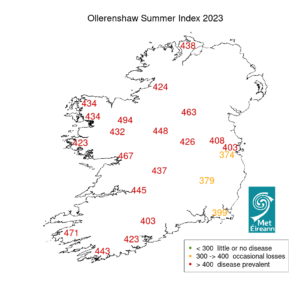Each year, the Department of Agriculture, Food and the Marine (DAFM) in collaboration with Met Éireann, UCD, Teagasc and Animal Health Ireland advises farmers of the predicted risk of liver fluke disease caused by a flat worm (Fasciola hepatica) in livestock for that winter. Liver fluke disease is economically important in cattle, sheep and goats. This year’s forecast is based on meteorological data gathered between May and October 2023 by Met Éireann.
Met Éireann use meteorological data to calculate the Ollerenshaw index, a predictive model used to evaluate the climatic conditions in a season which affect liver fluke development. The model uses monthly estimates of potential evapotranspiration and measured rainfall totals, together with the number of rain days (days with rain 0.2 mm) to derive the monthly contribution to the season’s index:
Where the value of the Ollerenshaw index exceeds 100 (as in a wet month) it is given a maximum value of 100. The development stage of the host snail is assumed to be slower in May and October due to lower temperatures, the maximum value of is halved for these months i.e. 50. The maximum value for the summer index is 500. The index is split into three categories of disease incidence:
- Total < 300 = Little or no disease,
- 300 <= Total <= 400 = Occasional Losses
- Total > 400 = High Prevalence of disease
Disease Forecast Summary
The Ollerenshaw Summer Index 2023 predicts infection being prevalent across all areas of Ireland except for south Leinster, where the risk of disease is somewhat lower (Figure 1). The high values of the index are due to the warm, wet conditions experienced in July, August, September and October.
Monitoring of Disease
Liver fluke infection tends to be chronic in cattle, resulting in ill-thrift and poor performance. Though chronic disease can also occur in sheep, infections may also result in more acute clinical signs, and sudden death in cases of heavy challenge.
Livestock owners should be vigilant for any signs of illness or ill-thrift in their animals and consult with their private veterinary practitioner (PVP) if they are concerned. In cases where the cause of death is not obvious, it is recommended that carcasses be referred by a PVP to the local Regional Veterinary Laboratory for post-mortem examination.
Abattoir records of livers of previously sold fattened stock is also a valuable source of information for livestock owners on the prevalence of liver fluke infection on their own farm or on the efficacy of their control programme.
Further detail on the incidence of liver fluke disease in 2023 and on treatment and control is available in the DAFM press release: https://www.gov.ie/en/press-release/ec21e-liver-fluke-forecast-november-2023/
